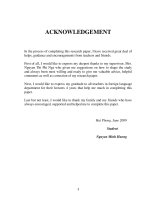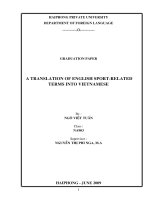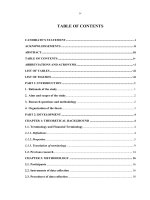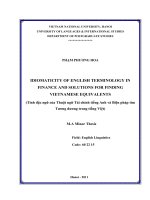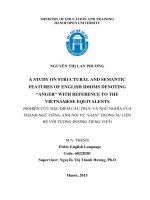A translation of English idioms on natural and geographical phenomena into Vietnamese
Bạn đang xem bản rút gọn của tài liệu. Xem và tải ngay bản đầy đủ của tài liệu tại đây (358.23 KB, 54 trang )
ACKNOWLEDGEMENT
In the process of completing this research paper, I have received great deal of
helps, guidance and encouragements from teachers and friends.
First of all, I would like to express my deepest thanks to my supervisor, Mrs.
Nguyen Thi Phi Nga who given me suggestions on how to shape the study
and always been most willing and ready to give me valuable advice, helpful
comments as well as correction of my research paper.
Next, I would like to express my gratitude to all teachers in foreign language
department for their lectures 4 years that help me much in completing this
paper.
Last but not least, I would like to thank my family and my friends who have
always encouraged, supported and helped me to complete this paper.
Hai Phong, June 2009
Student
Nguyen Minh Huong
1
TABLE OF CONTENTS
- Acknowledgements
- Table of contents
PART I: INTRODUCTION………………………………………..1
1.Rationale of the study…………………………………...................................1
2.Research method……………………………………………….......................1
3.Study restriction and research………………………………….......................2
PART II: DEVELOPMENT……………………………………….4
Chapter 1. THEORETICAL BACKGROUND…………………………......4
1.1
What is translation?....................................................................................4
1.2
Translation types………………………………………………………….6
1.2.1 Word-for-word translation…………………………………...................6
1.2.2 Literal
translation……………………………………………………6
1.2.3 Faithful translation………………………………………………….7
1.2.4 Semantic
translation…………………………………………………7
1.2.5 Adaptation………………………………………………………….8
1.2.6 Free translation……………………………………………………..8
1.2.7 Idiomatic translation……………………………………………….9
1.2.8 Communicative translation…………………………………………10
1.2.9 Translation by using a loan word. ………………………………10
1.2.10 Shift or transposition translation………………………………..10
1.3
An overview of idioms…………………………………………12
1.3.1 What is an idiom?........................................................................12
2
1.3.2 Translation equivalence………………………………………..14
1.3.3 Non-equivalent cases……………………………………………14
1.3.3.1 Transliteral…………………………………………………….16
1.3.3.2 Explanation…………………………………………………17
CHAPTER 2. TRANSLATION OF ENGLISH IDIOMS ON NATURAL
AND
GEOGRAPHICAL
PHENOMENA
INTO
VIETNAMESE………18
2.1 The meanings of English idioms on natural and geographical
phenomenon………………………………………………………………….1
8
2.2 English idioms on natural and geographical phenomenon compared to
Vietnamese
equivalent……………………………………………………….24
CHAPTER 3. SUGGESTED SOLUTION FOR NON-EQUIVALENT
IN TRANSLATION………………………………………………………..36
3.1.
Non-equivalent
cases
and
explanation…………………………………..36
3.2.
Suggested
solutions……………………………………………………...41
3.2.1 Influence on the culture, the nature and the social condition………….41
3.2.2 Identifying idioms……………………………………………………..41
3.2.3
Guessing
meaning………………………………………………….42
3
the
3.2.4
Using
idioms
in
the
suitable
situation………………………………….42
3.2.5
Finding
Vietnamese
equivalents……………………………………….42
3.2.6 Suggested exercises on English idioms………………………………..43
PART
III:
CONCLUSION………………………………………45
REFERENCE……………………………………………………………….4
7
4
Part One: INTRODUCTION
1. RATIONALE
Culture exchange and foreign trade exchange are definitions quite familiar
with every Vietnamese people in the 21st century. When more importantly,
our country is member of world organization trade (WTO), culture exchange
or international business cooperation is boosting than ever before.
My passion is ancestor‟s saying or idioms since I started going to school. In
my mind, there always happened a question that why or where our ancestor
created incredible idioms. And my suspect is more and more greater when I
enter into my university - their places that help me develop my instinct
comprehensively. On the other hand, to understand and communicate English
effectively we should not only pay attention to vocabulary, grammar,
intonation but master idioms as well. However, “what is an idiom?” I only
know that it is very important to all English learners because the
misunderstanding
of
idiom
meanings
causes
the
bad
effects
in
communication. But how can idioms affect communication? I know a bit
little. So I went to ask so many learners of English as a foreign language this
question. But what I received was that “it is very important”, but little more.
Being a student of English, I am too shocked in this problem and my desire is
to make it clear and to get more comprehensive and specific understanding.
2. RESEARCH METHOD
In order to learn English idioms on natural and geographical phenomena and
Vietnamese equivalent better the following methods are used in the studying
process:
+ Having discussion with supervisors, teachers and friends.
5
+ Collecting in file with other words and idioms which have similar
meaning
+ Accessing internet or reference in workbook, dictionary and search
libraries.
3. RESEARCH PURPOPSE AND RESTRICTION
The purpose of this graduation thesis has primarily been to define and
describe idioms frequently seen in English – Vietnamese translation which
does not completely ruin the whole work though, may confuse or puzzle
readers of the target language. To further develop the argument, the thesis
works out some of the major causes of non-equivalence in English –
Vietnamese translations by not only students of English but also people who
practice translating as their profession. Each cause is presented with typical
examples taken out from published materials like newspaper articles,
translated literary works, and students‟ translation exercises as well as
assignments. The thesis then boldly suggests possible solutions, i.e. a number
of strategies translators and would-be translators can employ to address or, at
least, minimize these common mistakes.
Idiom is a treasure of each country and it‟s too difficult to study about the all
English idioms because of its immense number. Moreover, my knowledge
and time for this study is limited. So, I only study on English idioms on
natural and geographical phenomena into Vietnamese the equivalent and nonequivalent between Vietnamese and English idioms.
Being aware of the fact that idioms are extremely difficult topic and merely
well-understood by foreign English learners and even if native speakers of
English who take the idioms for granted because when they use idioms, they
don‟t know that they are using them, however, appreciate the idioms
associated to attitude and behavior of the speakers. So when they hear
6
foreigners make grammatical or pronunciation mistakes, they are quite
willing to accept and understand them. But if inappropriate idioms are used
then, they might not understand what person means and that lead to a
misunderstanding and boring conversation. Therefore, my research is aimed
at:
+ Giving the knowledge of geographical and natural idioms.
+ Distinguishing different kinds of geographical and natural idioms.
+ Raising the learners‟ awareness of the existence of geographical and
natural idioms and the effects using them on communication.
+ Helping the learners use right idioms in right situation.
+ Helping learners compare the equivalent and non-equivalent between
English and Vietnamese geographical and natural idioms.
7
Part Two: DEVELOPMENT
CHAPTER 1: THEORETICAL BACKGROUND
1.1. What is translation?
Translation is very important but also difficult for English learners.
Translation has existed in every corner of our life. It is considered as an
indispensable part in the field of not only literature ,culture and religion but
also commercial advertisement ,popular entertainment ,public administration
,international diplomacy, scientific research publication ,judiciary procedure
,immigration and education ….Thus, definitions of translation are numerous
and a large numbers of writers have written about this subject In this paper,
some various concepts of translation have been collected as follows:
- Translation is the copy made in one language of what has been written, or
spoken in another.
- Translation consists of producing in the target language the closet natural
equivalent of the source language message, firstly with respect to meaning
and secondly with respect to style.( E.A.Nida, 1959)
- Translation is the action of interpretation of the meaning of a text, and
subsequent production of an equivalent text, also called a translation, that
communicated the same message in another language. The text to be
translated is called the “source text”, and the language it is to be translated
into is called the “target text.”
- Translation is the transformation of a text originally in one language into an
equivalent in the content of the message and the formal features and the roles
of the original text ( Bell , 1991).
8
- Translation is made possible by an equivalent of thought that lies behind its
different verbal expressions (Savory , 1968).
- Translation is rendering the meaning of a text into another language in the
way that author intended the text (Newmark , 1988).
- Translation, as process of conveying messages across the linguistic and
cultural barriers, is an eminently communicative activity, one whose use
could be well considered in a wider range of teaching situation than may
currently be the case (Tudor, cited in Duff, 1989: 5).
Although these definitions are different in expression, they share common
features about finding the closest equivalence in meaning by the choice of
appreciate
target
language‟s
lexical
and
grammatical
structures,
communication situation, and cultural context. Some sort of movement from
one language to another depends on translation types that will be show in the
next part.
Or sometimes translation is defined simply such as “a piece of writing or
speech that has been translated from a different language.”
For example:
“On the sly he leads a very gay life.”
In order to translate this sentence correctly we should analyze it clearly.
“On the sly” means secret, “Lead a gay life” refer to a licentious life. So this
sentence is translated into Vietnamese “Anh ta giấu cuộc sống hết sức trác
táng của mình.”
Or:
“He promised to give his son anything within reason for his twenty-first
birthday.”
9
In this sentence we should pay attention to phrase “anything within reason”.
Anything within reason means reasonable anything which father‟s ability can
give his son. In some countries, adolescent at the age of 21 can be considered
as a mature person. This sentence mean: “Ông ta đã hứa tặng cho con trai
mình bất cứ thứ gì vừa túi tiền nhân dịp sinh nhật lần thứ 21 của cậu ấy.”
1.2Translation types.
The translation types are often categorized by the number of areas of
specialization. Each specialization has its own strategies and difficulties.
Some translation types are list as following:
1.2.1 Word-for-word translation: the SL word order is preserved and the
words are translated by their most common meanings. Cultural words are
translated literally. The main use of this method is either to understand the
mechanics of the source language or to construe a difficult text as pretranslation process.
For example:
My father is proposed by the director
Bố tôi được đề bạt bởi giám đốc
1.2.2 Literal translation:
Literal translation is a broader form of translation, each SL word has a
corresponding TL word, but their primary meanings may differ. The SL
grammatical constructions are converted to their nearest TL equivalents but
the lexical items are again translated out of context. Literal translation is
considered the basic translation step, both in communicative and semantic
translation, in that translation starts from there. As pre-translation process, it
indicates problems to be solved.
For examples:
10
The careless watchman was responsible for the fire to a great extent.
Người bảo vệ bất cẩn chịu trách nhiệm phần lớn về vụ hoả hoạn.
He must use his personal property to settle the debts of the business of he
goes bankrupt.
Anh ta phải dùng tài sản cá nhân của mình để trả món nợ của doanh nghiệp
nếu anh ta bị phá sản.
1.2.3 Faithful translation:
Faithful translation attempts to reproduce the precise contextual meaning of
the original within the constrains of the TL grammatical structures. It
transfers cultural words and preserves the degree of grammatical and lexical
deviation from SL norms. It attempts to be completely faithful to the
intentions and the text-realization of the SL writer.
For example:
Today the Vietnamese are, almost no exception, extremely friendly to
Western visitors.
Ngày nay, người Việt Nam, gần như không có ngoại tệ, đều rất thân thiện với
khách du lịch người phương Tây.
(Text book for Translation 1-Haiphong private university)
1.2.4 Semantic translation:
Semantic translation differs from faithful translation only in as far as it must
take more account of the aesthetic value of the SL text, compromising on
meaning where appropriate so that no assonance, word play or repetition jars
in the finished version. It does not rely on cultural equivalence and makes
very small concessions to the readership .While faithful translation is
dogmatic, semantic translation is more flexible. Newark (1982:22) says
11
that”…semantic translating where the translator attempt, within the base
syntactic and semantic constrains of the TL, to reproduce the precise
contextual meaning of the author”.
For example:
Today the Vietnamese are, almost no exception, extremely friendly to
Western visitors
Ngày nay, người Việt Nam đều rất thân thiện với các khách du lịch nước
ngoài.
(Text book for Translation 1-Haiphong private university)
1.2.5 Adaptation:
This is the freest form of translation mainly used for plays and poetry: theme,
characters, plots preserved, SL culture converted to TL culture and text is
rewritten. Dung Vu (2004) points out that “Adaptation has a property of
lending the ideas of the original to create a new text used by a new language
more than to be faithful to be original. The creation in adaptation is
completely objective in contents as well as form”.
For example:
Thà một phút huy hoàng rồi chợt tắt
Còn hơn buồn le lói suốt trăm năm
(Xuân Diệu)
It would rather the victorious brightness
In an only moment the centenary twinkle
12
1.2.6 Free translation:
Free translation reproduces the matter without the manner, or the content with
out the form of the original .Usually it is a paraphrase much longer than the
original, a so-called “intralingua translation “often prolix and pretentious and
not translation at all
The advantage of this type of translation is that the text in TL sound more
natural .On the contrary, the disadvantage is that translating is too casual to
understand the original because of its freedom (Dung Vu, 2004,
www.talawas.org)
For example:
To reduce fertility rate the present 3.7 children per woman to replacement
level of 2.
Tỉ lệ sinh hiện tại của phụ nữ giảm từ 3,7 xuống còn 2 trẻ.
1.2.7 Idiomatic translation:
Idiomatic translation is used for colloquialism and idioms whose literalism is
the translation by which the translator does not transfer the literalism of the
original, uses the translation of colloquialism and idioms.
For instance:
“He is a really strict and crude boss. He breaks his staff’s back all week.”
The phrase “to break somebody’s back” is not only understood as someone
back is broken. It has an idiomatic meaning. It means force somebody to work
hard. So the sentence “He breaks his staff‟s back all week” means the boss
forces his staff work hard all week.
Or:
E.g.: Love me, love my dog
13
Yêu em yêu cả đường đi lối về
E.g.: Follow love and it‟ll flee thee, flee love and it will follow thee
Theo tình thì tình chạy, trốn tình thì tình theo
1.2.8 Communicative translation:
It attempts to render the exact contextual meaning of the original in such a
way that both language and content are readily acceptable and
comprehensible to the readership. “…But even here the translator still has to
respect and work on the form of the source language text as the only material
basis for his work” (Peter Newmark, 1982:39).
For example:
Good morning
Bác đi đâu đấy ạ!
Bác đi làm đồng đấy ạ!
1.2.9 Translation by using a loan word is particularly common in dealing
with culture-specific items, modern concepts and buzz words. Using a loan
word is dramatically strong method applied for the word which have foreign
origin or have no equivalence in TL.
1.2.10 Shift or transposition translation: A “Shift” Cattford term or
“Transposition” (Vinay & Darbelnet) is a translation procedure involving a
change in the grammar from SL to TL. One type, the change in the word
order is named “Automatic translation”, and offers translator no choice.
There are many differences between idioms and proverbs:
14
Idiom
Proverb
1. Idiom is a regularly used from 1. Proverb is a saying that makes a
words, particularly in some way truth or piece of wisdom easier to
either to an individual or a group. It remember.
can from a style of communication.
2. An expression whose meaning in 2. A short popular sayings, usually of
not
predictable
from
the
usual unknown and ancient origin, that
meanings of its constituent elements, expresses effectively some common
as “go to the dog, let the cat out of places truth or useful thought, adages,
the bag, etc” or from the general saw.
grammatical rules of a languages as “
the table round” for “ the round
table”, and which is not a constituent
of a larger expression of like
characteristics.
3. A languages, dialect, or style of 3. A wise saying or precept, a
speaking peculiar to people.
didactic sentence.
4. A construction or expression of 4. A person or thing that is
one language whose parts correspond commonly
regarded
as
an
to elements in another language but embodiment or representation of
whose total structure or meaning is some quality, by word.
not matched in the same way in the
second language.
15
5. The peculiar character or genius of 5. In a biblical sense, a profound
a language.
saying, maxim, or oracular utterance
requiring interpretation.
1.3 An overview of idioms
1.3.1 What is an idiom?
It is important to recognize that idioms are not only colloquial expression as
many people believe. They appear in formal style, in slang, in poetry. . .
There is very often no way of guessing the meaning of an idiom simply by
looking at the individual words it contains.
What then is an idiom?
In Vietnamese Dictionary, they say about idioms as follow:
“Thành ngữ là một tập hợp từ đã quen dùng mà nghĩa thường không thể giải
thích được một cách đơn giản bằng nghĩa thường của các từ tạo nên nó.”
And according to The Oxford Learner‟s Dictionary:
“An idiom can be defined as a number of words which when taken together,
have a different meaning from the individual meanings of each word.”
And another definition of idiom:
“Idioms are words, phrases, or expression that can not be taken literal. In
other words, when used in everyday language, they have the meaning other
than the basic one you would find in the dictionary. Every language a lot
easier and more fun”
And sometimes idioms are defined as “a phrase, construction, or expression
that is understood in a given language. This expression has a meaning that
16
differs from typical syntactic patterns or that differs from the literal meaning
of its parts taken together.”
In fact, this is what can make idioms all the more confusing.
For example, the learner may know the words get and goat, and wonder why
she doesn‟t understand the sentence You get my goat! In fact, she has little
chance of guessing, out of context, that it means You irritate me!
Or other examples:
E.g.: “Break a leg”
- Literal meaning someone‟ leg is broken and he or she should go to the
doctor afterwards to get it fixed.
- Idiomatic meaning: do your best and do well. Often, actors tell each
other to “break a leg” before they go out on stage to perform.
E.g.: “To kick the bucket”
“Peter was very surprised when he heard that Mary‟s husband kicked the
bucket one year ago”.
Here, the phase “kicked the bucket” doesn‟t mean the literal meaning as usual
but it has an idiom meaning. That is “to die”. So we can understand this above
sentence that Peter was surprised because Mary‟s husband died one year ago.
E.g.: “To throw in the tower”
“Because of her, he is willing to throw in the tower even his current job”
This sentence can‟t be understood that he is willing to throw his job in the
tower, because of her as literal meaning. The phrase “throw in the tower”
means: to stop or to give up. So this sentence should be understood that
because of her, he is willing to give up even his current job.
17
E.g.: “Give a hand”
“Give a hand” is an idiom and its meaning can not exactly be deduced from
its components because if we analyze its literal meaning, the idiom will be
translated that someone wants to borrow somebody‟s hand. But its real
meaning does not lie in the surface of words, hand is a part of human body
and function is to work. Therefore, when somebody has its do something for
him he will say “give me a hand”. “Give me a hand” is not for shaking here
but for working, so “give me a hand” means “need a help”.
In conclusion, the above ideas are in common, it is difficult to define idioms
exactly but we can confirm that are fixed expressions and their meaning are
understood indirectly through visible words in each.
1.3.2 Translation equivalence.
The comparison of texts in different languages inevitably involves a theory of
equivalence. Equivalences can be said to be the central issue in translation
although its definition, relevance, and applicability within the field of
translation theory have caused heated controversy, and many different
theories of the concept of equivalence have been elaborated within this field
in the past fifty years. Pym (1992) has pointed to its circularity: equivalence is
supposed to define translation, in turn, defines equivalence. Here are some
elaborate approaches to translation equivalence:
- Translational equivalence is the similarity between a word (or expression) in
one language and its translation in another. This similarity results from
overlapping ranges of reference.
- A translation equivalent is a corresponding word or expression in another
language.( Lingua Links Library, Version 5.0 published on CD-ROM by SIL
International, 2003).
18
Nida argued that there are two different types of translation equivalence,
namely formal equivalence- which in the second edition by Nida and Taber
(1982) is referred to as formal correspondence- and dynamic equivalence.
Formal correspondence “focuses attention on the message itself, in both form
and content”, unlike dynamic equivalence which is based upon “the principle
of equivalent effect” (1964:159). In the second edition (1982) or their work,
the two theorists provide a more detailed explanation of each type of
equivalence.
Formal correspondence consists of a TL item which represents the closest
equivalent word or phrase. Nida and Taber make it clear that there are not
always formal equivalents between language pairs. They therefore suggest
that these formal equivalents should be used wherever possible if the
translation aims at achieving formal rather than dynamic equivalence. The use
of formal equivalents might at times have serious implications in the TT since
the translation will not be easily understood by the target audience (Fawcett,
1997). Nida and Taber themselves assert that “Typically, formal
correspondence distorts the grammatical and stylistic patterns of the receptor
language, and hence distorts the message, so as to cause the receptor to
misunderstand or to labor unduly hard” (ibid: 201).
Dynamic equivalence is defined as a translation principle according to which
a translator seeks to translate the meaning of the original in such as way that
the TL wording will trigger the same impact on the TC audience as the
original wording did upon the ST audience. They argue that “Frequently, the
form of the original text is changed; but as long as the change follows the
rules of back transformation in the source language, of contextual consistency
19
in the transfer, and of transformation in the receptor language, the message is
preserved and the translation is faithful” (Nida and Taber, 1982:200).
Newmark (1988) defines that: “The overriding purpose of any translation
should be to achieve „equivalence effect‟ i.e. to produce the same effect on
the readership of translation as was obtained on the readership of the
original”. He also sees equivalence effect as the desirable result rather than
the aim of any translation except for two cases: (a) If the purpose of the SL
text is to affect and the TL translation is to inform or vice ; (b) If there is a
pronounced cultural gap between the SL and the TL text.
Keller (1979) considers fives types of equivalence:
- Denotative equivalence: the SL and the TL words refer to the same thing in
the real world. It is an equivalence of the extra linguistic content of a text.
- Connotative equivalence: This type of equivalence provides additional value
and is achieved by the translator‟s choice of synonymous words of
expressions.
- Text-normative equivalence: The SL and the TL words are used in the same
or similar context in their respective languages.
- Pragmatic equivalence: With readership orientation, the SL and TL words
have the same effect on their respective readers.
- Formal equivalence: This type of equivalence produces an analogy of form
in the translation by either exploiting formal possibilities of TL, or creating
new forms in TL.
Although equivalence translation is deferent point of view of theorists, it is
same effective equivalence between SL and TL.
20
1.3.3 Non-equivalent cases.
1.3.3.1 Transliteral.
When we see the individual word, we can guess the meaning of the idioms.
For example:
- Build bridges: means when there are some people or groups don‟t have
same ideas or argument with each other, you will help them to
cooperate and understand each other better. You have a function as a
bridge to cooperate them.
- Like a thief in the night: means someone does something secretly or in
an unexpected manner.
- Go too far: refers to the action that you do id considered extreme or
unacceptable.
- Make someone see reason means you persuade them to stop acting
foolishly and behave more sensible.
1.3.3.2 Explanation
The idioms can‟t be guessed the meaning by seeing the individual word but
only explanation.
For example:
- Play truant: means you stay away from school without permission or
excuse.
- Couch potato: you refer to someone who is spending a lot of time
sitting and watching television.
- All ears: means you are listening very attentively.
- Tell a white lie: means to say something which is not true in order to
protect someone or to avoid hurting their feelings.
21
CHAPTER 2: TRANSLATION OF ENGLISH IDIOMS
ON NATURAL AND GEOGRAPHICAL
PHENOMENA INTO VIETNAMESE.
2.1 The meanings of English idioms on natural and geographical
phenomenon.
E.g. 1: (on) cloud nine: extremely happy
Andrea was on cloud nine when she bought her new car.
E.g.2: dig deep: look hard for information
I had to dig deep to find my old report cards.
E.g.3: dirt cheap: very inexpensive
The clothes at the thrift shop are dirt cheap.
E.g.4: down to earth: natural or real (personality)
Lucile is really down to earth for a woman with so much money.
E.g.5: fair-weather friend: a person who is only a friend in good times
I can't talk to Nancy about my boyfriend problems. She's only a fair-weather
friend.
E.g.6: a field day: a very enjoyable time
The kids had a field day at the water slide park.
E.g.7: go downhill: get progressively worse
My grades started going downhill when I got a part-time job.
E.g.8: go with the flow: continue in the same way as others
Nobody trained me at work. I just went with the flow.
E.g.9: hit the hay: go to sleep
I'm exhausted. I think I'll hit the hay early tonight.
E.g.10: hit the road: leave
It's getting late. We had better hit the road.
E.g.11: keep one's head above water: have just enough money to live
22
It's hard to keep my head above water with all of these medical bills.
E.g.12: know which way the wind blows: know how things will turn out
Who knows which way the wind will blow? I just hope Jesse gets one of the
jobs he's applied for.
E.g.13: make a mountain out of a molehill: make a small problem seem big
The car only got a tiny dent. You're making a mountain out of a molehill.
E.g.14: out of the woods: clear of danger
The doctor said my heart is doing better, but I'm not out of the woods yet.
E.g.15: over the hill: past middle age
I knew I was over the hill when I started needing glasses to read.
E.g.16: rain on someone else's parade: ruin somebody else's happiness
Whenever I had a dance recital, my older brother always rained on my
parade.
E.g.17: stick-in-the-mud: a loner or person who won't join in
They didn't bother inviting Charles to the party because he's always a stickin-the-mud.
E.g.18: (as) quick as lightning: very fast
Wow! Your shower was as quick as lightning.
E.g.19: the tip of the iceberg: a small part of a large problem
The lost tickets were just the tip of the iceberg.
E.g.20: take a rain check: accept at a later date
I'd love to go out for dinner, but can I take a rain check?
E.g.21: under the weather: ill
I was feeling under the weather so I went back to bed.
E.g.22: up the creek: in trouble
If my Dad finds out I had a party I'll be up the creek.
E.g.23: win by a landslide: win by a lot of points
The skier in the green coat won by a landslide.
23
E.g.24: (get) wind of something: overhear something about someone or
something (often gossip)
My Dad has a new girlfriend. I got wind of it over dinner tonight.
E.g.25: Bolt from the blue: If something happens unexpectedly and
suddenly, it is a bolt from the blue.
E.g.26: Brighten up the day: If something brightens up your day, something
happens that makes you feel positive and happy all day long.
E.g.27: Calm before the storm: A calm time immediately before period of
violent activity or argument is the calm before the storm.
E.g.28: Chase rainbows: If someone chases rainbows, they try to do
something that they will never achieve.
E.g.30: Cloud of suspicion: If a cloud of suspicion hangs over an individual,
it means that they are not believed or are distrusted.
E.g.31: Cloud on the horizon: If you can see a problem ahead, you can call it
a cloud on the horizon.
E.g.32: Cold light of day: If you see things in the cold light of day, you see
them as they really are, not as you might want them to be.
E.g.33: Colder than a witches tit: If it is colder than a witches tit, it is
extremely cold outside.
E.g.34: Come rain or shine: If I say I'll be at a place come rain or shine, I
mean that I can be relied on to turn up; nothing, not even the vagaries of
British weather, will deter me or stop me from being there.
E.g.35: Doldrums: If a person is in the doldrums, they are depressed. If a
project or something similar is in the doldrums, it isn't making any progress.
E.g.36: Down in the doldrums: If somebody's down in the doldrums, they
are depressed and lacking energy.
E.g.37: Dry spell : If something or someone is having a dry spell, they aren't
being as successful as they normally are.
24
E.g.38: Every cloud has a silver lining : People sometimes say that every
cloud has a silver lining to comfort somebody who's having problems. They
mean that it is always possible to get something positive out of a situation, no
matter how unpleasant, difficult or even painful it might seem.
E.g.39: Face like thunder: If someone has a face like thunder, they are
clearly very angry or upset about something.
E.g.40: Once in a blue moon: If something happens once in a blue moon, it
occurs very rarely
“Bill has very little contact with his brother. They see each other once in a
blue moon.”
E.g.41: Get wind of: If you get wind of something, you hear or learn about it,
especially if it was meant to be secret.
E.g.42: Greased lightning: If something or someone moves like greased
lightning, they move very fast indeed.
E.g.43: Head is in the clouds: If a person has their head in the clouds, they
have unrealistic, impractical ideas.
E.g.44: Hit rough weather: If you hit rough weather, you experience
difficulties or problems.
E.g.45: In a fog: If you're in a fog, you are confused, dazed or unaware.
E.g.46: Into each life some rain must fall: This means that bad or
unfortunate things will happen to everyone at some time.
E.g.47: It never rains but it pours: 'It never rains but it pours' means that
when things go wrong, they go very wrong.
E.g.48: Jack Frost:If everything has frozen in winter, then Jack Frost has
visited.
E.g.49: Know which way the wind blows: This means that you should know
how things are developing and be prepared for the future.
25

